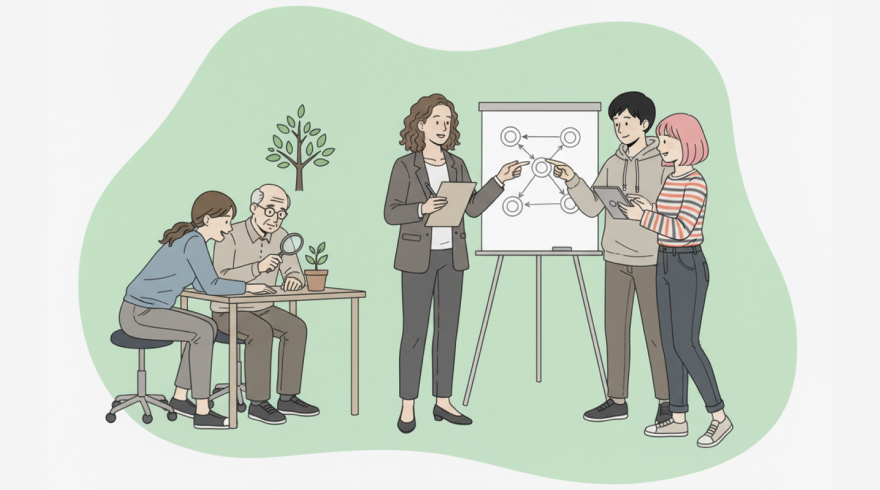The Complete Guide to Modern Leadership Style Assessment
- 21 October 2025

Why Systematic Leader Evaluation Matters
In an environment defined by volatility and rapid change, organizations cannot rely on charisma or gut feeling to pick the right people for pivotal roles. Stakeholders need defensible methods that distinguish durable capability from short-term charm. A robust process helps teams spot the blend of judgment, empathy, and execution that sustains results over the long haul. When evidence-based evaluation becomes routine, decision quality improves, bias shrinks, and talent conversations become far more productive.
Beyond intuition, rigor turns potential into predictable performance by bringing structure to ambiguous choices. Across industries, hiring teams rely on leadership assessment tests to benchmark potential beyond resumes and interviews. The best programs triangulate data from multiple sources and reduce the risk that any single measure dominates the narrative about a candidate. Over time, this discipline compounds into a stronger bench and clearer succession pathways.
Nuanced evaluation also illuminates how leaders influence culture, motivation, and cross-functional collaboration. When organizations want nuance, they augment with a leadership style assessment that surfaces behavioral tendencies for context and coaching. Richer feedback enables tailored development plans instead of generic training menus. Teams then align growth opportunities with business strategy, accelerating readiness for stretch assignments and critical transformations.
What a Rigorous Assessment Reveals and Why It Works
Sound leader diagnostics aim to answer three big questions: what someone can do, what they will do, and in which contexts they will likely thrive. Competency models map observable behaviors to both current role demands and future strategy. Psychometrics explore personality drivers, risk preferences, and cognitive approaches that shape choices under pressure. Together, these inputs reveal patterns that might otherwise remain hidden until a high-stakes moment exposes them.
For promotion pipelines, many boards formalize a leadership assessment so decisions feel fair and repeatable across divisions and geographies. Consistency matters because scattered practices create perception gaps that erode trust. Clear standards, calibrated raters, and traceable outcomes help leaders understand what “good” looks like and how to close distance to it. The result is a system that treats potential as something developable, not mystical.
To cut bias, HR partners deploy modern leadership assessment tools that blend psychometrics with work samples and simulations. These instruments generate structured observations under realistic conditions, making it easier to separate confidence from competence. Consider incorporating multiple rater viewpoints, longitudinal data, and role-relevant scenarios. The following checklist can guide your approach:
- Define the must-have competencies tied directly to your strategy.
- Blend qualitative insights with quantitative scores for balance.
- Use scenarios that mirror real decision pressures in your context.
- Calibrate evaluators and audit results to reduce drift over time.
- Translate findings into specific, time-bound development actions.
Methods, Instruments, and How to Mix Them
Great evaluation programs combine breadth and depth without overwhelming participants. Behavioral interviews surface examples of past decisions and their consequences. Simulations and in-basket exercises recreate constraints that force prioritization, delegation, and strategic trade-offs. Peer and stakeholder feedback adds texture by showing how someone’s style lands across the ecosystem, not just with direct reports.
For reflective insight, many professionals start with a leadership self assessment that encourages honest appraisal and concrete goal-setting for the next quarter. That reflection is most useful when framed by clear competencies and reinforced by manager dialogue. When participants own their growth plans, coaching sticks and learning accelerates. Layering data sources ensures the development path is both personalized and anchored in evidence.
| Method | Best use case | Time required | Signal strength | Common pitfalls |
|---|---|---|---|---|
| Behavioral interview | Exploring past decisions and learning agility | 60–90 minutes | Medium | Story polish can mask weak causality |
| Work simulation | Observing judgment under realistic constraints | 2–4 hours | High | Scenarios not tailored to role context |
| 360 feedback | Gathering multi-rater perspective on influence | 2–3 weeks | Medium–High | Uncalibrated raters or vague prompts |
To validate perceptions, teams add a formal leadership assessment test that aligns ratings with observable behavior in consistent conditions. Combining these angles creates a rounded picture that resists single-data-point bias. The integrated output should flow directly into individualized development plans with milestones and measurable outcomes. That way, insight swiftly translates into capability growth.
Implementing Your Program and Measuring What Matters
Successful rollouts start with clarity on purpose, scope, and governance. Leaders must know how results will be used, who will see them, and what support follows. Transparency builds trust, while strong data privacy practices reassure participants that candor will not backfire. Pilot programs help iron out logistics and reveal where language, timing, or technology could be improved before scaling.
Some HR templates literally label the rubric as an assessment leadership skills document to standardize what good looks like across teams. Alignment with role architecture ensures that expectations are consistent from frontline supervisors to enterprise executives. Reporting should spotlight trendlines by function, cohort, and level, enabling targeted interventions. Development resources coaching, mentoring, and coursework then map cleanly to the most material gaps.
For budget-conscious teams, a reputable free leadership assessment test can be a starting point before investing in enterprise-grade platforms. While lighter tools require careful interpretation, they can still reveal patterns worth exploring in manager one-on-ones. As the program matures, integrate learning management systems, feedback cycles, and performance data to create a cohesive growth engine. Momentum builds when development becomes a shared responsibility, not a once-a-year ritual.
Interpreting Results and Turning Insight Into Action
Numbers alone do not change behavior; meaning and practice do. Facilitate debriefs that connect findings to specific work situations and near-term goals. Translate abstract competencies into micro-behaviors that can be rehearsed during real projects. Encourage peer coaching circles where leaders experiment, reflect, and iterate. Over time, these routines embed continuous improvement into the fabric of everyday work.
For a quick temperature check, a lightweight leadership style assessment free option can spark productive reflection prior to coaching sessions. When deeper development is needed, combine targeted practice with shadowing, stretch assignments, and structured feedback. Coaches should help participants craft two-week experiments that build momentum without adding bloat. Progress tracking keeps energy high and highlights which interventions truly move the needle.
Across the portfolio, well-governed leadership assessments feed talent reviews and succession planning with consistent evidence for critical choices. As datasets grow, analytics can reveal leading indicators of derailment risk and readiness. Share success stories that connect development efforts to business outcomes such as retention, engagement, and customer impact. These narratives reinforce that capability building is not optional it is a competitive advantage.
Faq: Common Questions About Leader Evaluation
What is the purpose of evaluating leaders in a structured way?
Structured evaluation clarifies expectations, reduces bias, and aligns development with strategy. Instead of guessing, organizations use evidence to match people to roles where they can create the most value. The process also increases fairness, because standards are transparent and consistently applied across teams and levels. Over time, this reliability strengthens culture and builds confidence in promotion decisions.
How do I choose the right instruments for my context?
Start by mapping the essential competencies to future business needs and risk areas. For day-to-day coaching, a targeted leadership skills assessment will spotlight strengths and gaps without overwhelming detail. Mix methods interviews, simulations, and multi-rater input to balance perspective and reduce single-source bias. Pilot, gather feedback, and refine before expanding across the enterprise.
How should results be shared with participants?
Share insights in a supportive debrief that focuses on growth, not judgment. Pair the discussion with a practical plan that includes specific behaviors to practice, resources to use, and checkpoints to revisit. Managers should reinforce progress in regular one-on-ones, celebrating quick wins and adjusting goals as conditions change. Confidentiality and clarity about usage are essential for trust.
Are low-cost options worth considering for small teams?
Smaller organizations can still gain traction with pragmatic, well-curated tools and careful facilitation. If budget is tight, a credible leadership assessment test free alternative can still yield directional insights for early conversations and prioritization. As needs grow, layer more rigorous instruments and coaching to deepen precision. The key is translating any insight into concrete actions that compound over time.
How do I ensure assessments lead to real development?
Turn findings into short, repeatable experiments that align with current work. Build accountability with peer coaching, periodic check-ins, and visible milestones. Keep the focus on a few high-impact behaviors rather than sprawling wish lists. When progress is measured and celebrated, motivation rises and capability strengthens in a durable way.



